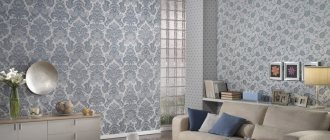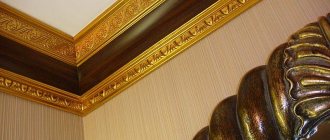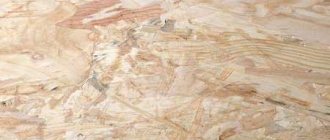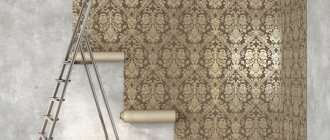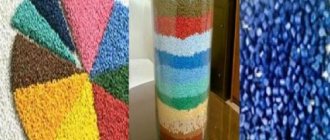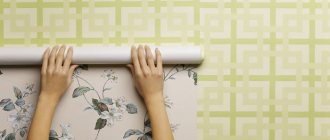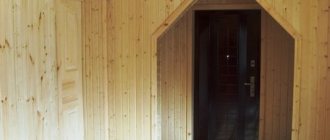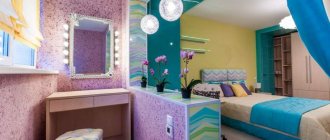Plastic panels made of polyvinyl chloride are an excellent option for wall decoration. Thanks to the high manufacturability of PVC, wall panels made from it have firmly taken their place as the most popular material for interior work.
However, sooner or later, under the influence of external factors, PVC panels lose their aesthetics and require replacement with a newer finishing material. In this regard, homeowners often have a question: is it possible to glue wallpaper onto plastic panels without dismantling them?
Technical features of PVC panels and wallpaper
To apply wallpaper to PVC, you need to choose the right primer
It should be said right away that wallpapering plastic panels is quite acceptable. With the modern development of technical progress, there are practically no completely incompatible finishing materials left. You just need to follow the technology for combining them: choose the right primer and adhesive composition.
To better understand all the intricacies of wallpapering a wall previously finished with plastic, you should familiarize yourself with the technical features of both materials.
PVC panels
Plastic panels have earned such wide popularity in interior design due to the following properties:
- Affordable price. According to this indicator, PVC panels are one of the leaders in the wall panel segment.
- Excellent resistance to high humidity. Thanks to this, PVC wall panels can be used to decorate bathrooms, toilets and open balconies.
- Resistance to ultraviolet radiation. PVC panels withstand exposure to sunlight, practically without losing brightness and color saturation.
- Ease of installation. The panels have special locks on their edges for easy connection. Using “liquid nails” and self-tapping screws, you can glue the panels to the wall or screw the sheathing to the frame.
The glossy surface of the panels makes it difficult to wallpaper
This representative, like any other finishing materials, has its own disadvantages. First of all, this is low resistance to open flame, as well as the release of toxic chemical components during combustion.
As a result, they are not recommended for cladding walls in rooms with a high probability of ignition - kitchens, electrical rooms, production workshops, etc.
But the main feature of PVC panels is their smooth glossy surface. On the one hand, this gives the cladding high decorative qualities, but on the other hand, it makes it very difficult to finish them with any material, both paint and varnish compounds and wallpaper.
Low adhesion rates between the smooth surface of plastic and any adhesive or paint composition do not allow high-quality wallpapering without special preparation.
Wallpaper
This type of decorative wall covering has been at the peak of popularity for decades. Wallpapers are able to stay on trend thanks to regular updates of the offered range. Today, wallpaper is not just paper rolls with a pattern printed on them.
Modern wallpapers also include high-tech types that have virtually nothing in common with their paper predecessors. Today, the following types of this finishing material are presented to the buyer:
- paper The simplest variety, characterized by low cost and low resistance to external influences;
- non-woven. A multilayer variety, where the base is a dense polymer fabric - non-woven fabric. The top decorative covering can be made of almost any material - from paper to vinyl and fiberglass;
- vinyl. Another option for multi-layer wallpaper, the main layer here is a polyvinyl chloride film. Depending on the base material and the number of layers, they can be either “light” or “heavy”.
In addition to these three main types of wallpaper, there are also more “exotic” varieties on our market: fiberglass, jute, “liquid wallpaper,” textile, etc.
Almost every type of wallpaper has its own gluing technology, as well as glue developed specifically for a certain type of wallpaper.
The most complete information about the technical features and method of use can be obtained by carefully reading the instructions on the packaging.
The table shows some symbols applied to the wallpaper when marking them, and their interpretation.
Choose high-quality mixtures for gluing
A variety of sticker technologies can also be used. When pasting certain types of wallpaper, for example, paper or vinyl, the adhesive composition is applied both to the canvas and to the wall. When gluing non-woven ones - only on the wall, etc.
Some adhesive solutions cling quite firmly to the base and the wallpaper, so when gluing you should be as precise as possible.
Other types of adhesive compositions allow you to move the canvases along the wall for some time after they have been glued, adjusting the texture and pattern.
Most adhesive compositions are designed for gluing wallpaper to a fairly porous base with good adhesion. Only on such bases can you properly glue the canvas without the risk that it will completely come off or swell with a bubble in the near future.
Gluing technology
For better adhesion to PVC wallpaper, you can upholster with fiberboard
Due to the above-mentioned features of both PVC wall panels and wallpaper adhesive compositions, it is not possible to obtain a sufficiently strong adhesion between them. Therefore, in order to cover PVC walls with wallpaper, it will be necessary to increase their adhesion. You can do this in two ways:
- Covering PVC walls with another material, more suitable for working with wallpaper glue. It is best to use fiberboard sheets in this case - they are quite cheap, easy to cut and install, and are also perfect for gluing wallpaper on them.
- Increased adhesion of PVC panels themselves.
The first option is quite understandable - fiberboard sheets are simply attached on top of PVC panels using self-tapping screws. The second requires special consideration. Preparing old polyvinyl chloride surfaces for wallpapering includes several stages.
Processing with abrasive materials
Abrasive sponge
Initially, the old plastic surface is thoroughly cleaned from dirt, dust, grease, etc. To do this, use a sponge soaked in soapy water or any household chemicals. After all dirt has been removed and the surface of the panels has been dried, the smooth plastic surface should be given a rougher texture.
To do this, you should use the so-called Scotch-Brite - an abrasive sponge. It needs to be properly processed over the entire plane of the panels. The movements should be intense, and sufficient pressure should be applied to the washcloth so that the glossy surface is covered with many small scratches.
In the absence of Scotch Brite, to give the plastic plane a rough structure, you can use fine-grained sandpaper or a sanding machine with a zero-point wheel.
After this treatment, the plastic panel becomes indistinguishable to the touch from a surface covered with putty or well-leveled plaster. That is, the adhesion of PVC panels using this operation was increased to quite acceptable levels.
Primer
Apply several coats of primer
Before applying the primer, the surface should be cleaned of fine dust remaining after treatment with abrasive materials. The primer composition is applied to the surface of the panels using a paint brush or roller. To do this, you should use a special primer composition designed for treating glossy surfaces - tiles, glass, plastic.
Considering such a “complex” base as a plastic plane, it is advisable to apply it in two or three layers. In this case, each subsequent layer must be applied no earlier than the previous layer has dried. After the primer has completely dried, you can begin gluing the wallpaper.
Wallpaper glue
After preparation, almost any glue should form a good adhesion to the PVC panel.
However, experts still recommend playing it safe by using a special composition for pasting wallpaper, prepared with your own hands; for this, ordinary wallpaper glue is taken and diluted in accordance with the type of wallpaper used (vinyl, non-woven, etc.).
Then universal PVA glue is added to it in a proportion of ¼ of the total mass of glue. For more information on how to hang wallpaper, watch this video:
PVA can significantly improve the technical characteristics of any wallpaper adhesive, and this composition will provide much stronger adhesion between the PVC panel and the wallpaper.
Application to various surfaces
Which surface can liquid wallpaper be applied to in order to get the best result? The answer is almost any. Therefore, further we will consider options for working with different wallpaper bases.
Which surface can liquid wallpaper be applied to in order to get the best result? The answer is almost any.
Drywall
The plasterboard surface is ideal for this coating; its structure is perfectly compatible with the liquid composition. Therefore, wallpaper applied to drywall will adhere and look good. But drywall, like other surfaces, needs to be prepared: primed, leveled the surface and applied a thin layer of plaster to it, which is then sanded. Next, a primer is applied, and if there are dark spots, the surface is painted with white paint so that they do not show through the coating. Before starting work, the wallpaper mixture is mixed again, applied to a spatula and applied to the surface with progressive movements. The layer should be thin, about a millimeter or two thick. It is advisable to go through one wall in one go.
The plasterboard surface is ideal for this coating; its structure is perfectly compatible with the liquid composition.
OSB boards
Since the protective layer of OSB does not allow the use of various liquid materials on it without preparation, it is necessary to remove it with a sanding machine before applying the wallpaper, you need to cover the surface with an acrylic primer, level the joining areas with putty, sand it and apply a final layer of primer on the concrete.
Since the protective layer of OSB does not allow the use of various liquid materials on it without preparation, it is necessary to remove it with a sanding machine before applying wallpaper.
Plywood
Before work, you should check that the plywood is securely fastened to the wall. To prevent plywood sheets from deforming under the influence of moisture, they should not be too thin. The wall is primed, and the untreated surface is covered with primer in 2-3 layers. Just like on other materials, if necessary, you should paint the wall with white paint
Oil paint will not allow the surface to “breathe”, and thus will remove this positive effect from using liquid wallpaper.
To prevent plywood sheets from deforming under the influence of moisture, they should not be too thin.
Emulsion paint
It is not advisable to apply wallpaper to old water-based paint; it is better to get rid of this coating by washing the walls with warm water, and then cover it with a primer and light paint.
It is not advisable to apply wallpaper over old water-based paint; it is better to get rid of this coating.
When to use the combination
Often, when decorating a room, we are forced to resort to using several types of finishing materials at once. In some cases, this can be explained by the design conditions and features that are inherent in a given room or apartment, and based on which we must make certain decisions on interior design. Very often, one of the optimal solutions is the use of combined types of finishing, when several decorative materials are used at once.
This approach makes it possible to focus on the obvious advantages, while hiding, at the same time, some of the disadvantages of both the room itself and each of the finishing materials. Today, one of the most popular solutions is a combination of wallpaper and panels: plastic, PVC, wood, MDF, SIP and others. By the way, this method has shown itself to be excellent when working in both residential and non-residential premises with high ceilings.
How to glue wallpaper on panels?
Many people wonder: is it possible to glue wallpaper to panels? Plastic (PVC), wood, MDF and others. In fact, to answer this question, you need to know some details about the use of this decorative material.
Please note that the market for construction and finishing materials offers a wide variety of different types of decorative wall panels.
Let's look at the most popular of them, and see if wallpapering on such surfaces is possible, and how to glue them correctly.
Pasting wallpaper onto PVC trim
A prerequisite for such gluing is the preliminary preparation of the working surface. Therefore, answering the question of whether it is possible to glue wallpaper on PVC plastic panels, we should say: yes, it is possible. However, it is necessary to remember that certain conditions must be met. So, what tools will you need and what is the sequence of your actions? Let's get a look:
- Prepare a primer for plastic and vinyl surfaces, a solvent or its equivalent, fine-grain sandpaper or its equivalent.
- First of all, treat the glossy surface, making it matte so that the wallpaper can stick to it, and wipe off all the fine dust.
- If possible, wipe the surface of the plastic with a slightly damp cloth and wait until it dries. It does not take a lot of time.
- Then you need to apply a primer designed for working with PVC and similar plastic-based materials.
- The next stage of work: surface treatment using a special adhesive primer diluted with white spirit. This is done using appropriate tools.
- After this, you can start gluing yourself and no longer worry about the question of whether it is possible to hang wallpaper on PVC plastic panels. The answer is of course positive: yes, it is possible!
Working with surfaces on wooden and combined bases
It should be remembered that today a huge number of decorative panels, which can be bought in specialized stores, as well as construction supermarkets in Russia and the CIS countries, are made from wood, or a combination of wood raw materials and other materials and elements, incl. fastening. In this case, we can mention not only wooden panels, but also the so-called SIP wall panels (OSB on both sides with a layer of insulation in the middle), which are used for the construction of prefabricated housing.
A design feature of many of these materials is that their production may not use any special fastening materials, such as glue or resin. Bonding of wood chips is made possible by the use of strong compression at elevated temperatures, as well as a special level of humidity. Thanks to an innovative approach to production, such materials are well known for their excellent performance characteristics.
Wallpaper can be glued to this type of panel, and the work itself does not differ in any special features compared to traditional wooden surfaces. Proceed by analogy. By the way, you can first read the articles on how to properly glue wallpaper onto plywood or similar surfaces.
At the same time, “liquid wallpaper”, which has already become popular, is often used to decorate SIP panels. What you need to know about their use:
- They have excellent performance characteristics and look beautiful.
- They are capable of hiding some minor imperfections of the wall on which they are applied.
- They are somewhat elastic. In other words, they are able to stretch a little, which is especially important when renovating new buildings.
- They are easy to install: even a non-professional can handle their application, subject to the instructions and recommendations.
Therefore, installation of liquid wallpaper on decorative surfaces, as well as on SIP panels, is quite simple. At the same time, you should remember that if you intend to use them in a room with a high level of moisture (when finishing a kitchen, bathroom, etc.), it is advisable to apply an additional protective layer of special varnish.
Types of panels for the bathroom
A large amount of material presented for sale has different external and quality characteristics.
By material
Bathroom panels can be made of different materials. When choosing, take into account its service life, ability to withstand a humid environment, strength, design and ease of installation. Material used for their manufacture:
- PVC (polyvinyl chloride);
- MDF (fine wood-fiber chips pressed using special compounds);
- wood (base - solid wood material).
PVC material is preferable for finishing the bathroom, as it meets all the requirements of small rooms with high humidity.
A hasty job can lead to the panels peeling off and the formation of fungus and mold underneath them. To prevent this from happening, you need to accurately select the material for the appropriate conditions and carry out repairs only after first familiarizing yourself with the work procedure. Otherwise, your efforts will be wasted.
By appearance
Depending on which working surface (walls, ceiling) the finishing material will be glued to, the panels have different appearances:
- leafy;
- rack and pinion;
- tiled.
Slat and tile panels are light in weight, quickly “grabbed” with glue, and you don’t have to fiddle with them for a long time during installation. The sizes of standard slatted panels are from 12.5 to 30 cm in width and 2.4-3.7 cm in length. Outwardly they look like clapboard. The tile material is produced in the form of squares with sides from 30 to 90 cm.
By purpose
PVC sheet panels for the bathroom are convenient to use for covering walls, since one sheet can cover a large area at once. The surface finished with them looks great, as there are few joints and visible seams. Having the skills in this work, making repairs is not difficult.
Plastic wall panels for the bathroom are also used in the form of slats. The ease of installation is ensured by the presence of grooves on one side and shelves on the other. Collecting them is like playing with a constructor.
Both slatted and tiled panels are equally suitable for ceilings. Both of them are light in weight. When gluing, they are not pulled down by their own gravity. Beautiful and varied design allows you to create a magnificent ornament. Ceiling panels for the bathroom are an inexpensive and labor-intensive option that allows you to get high-quality results.
How to combine correctly
Well, now is the time to understand the features of using various combined materials. Let us dwell on the main options that are most widely used when decorating modern apartments and country houses.
Using Fragments
To do this, you need to make an initial sketch in which ideas for interior design are recorded. After this, you will need to thoroughly prepare the working surface of the walls, after which the standard pasting procedure follows. However, that's not all. After the walls have been glued, panel inserts are installed in some areas instead of wallpaper, thus forming unique fragments.
Advice from the designer! The edging of such inserts can be made using separate decorative elements, such as moldings.
Combinations using room dimensions
If your room has sufficient height or width, it can serve as a place for such a design technique as horizontal or vertical combination of wallpaper and panels. Thanks to its versatility, this approach is perfect for any interior style. One of the most common techniques is to alternate different surfaces with wallpaper. So, you can use plastic panels, then wood, then wallpaper, then PVC again and so on. A kind of circle is formed.
In addition, you can combine not only different types of finishes, but also different colors. As for the correct choice of shades, it is advisable to use special color compatibility tables for this. Approximately the same as those used when selecting companion wallpaper for the walls of a room. In any case, you can see various examples of using combinations in the numerous photos presented in this article. Experiment and don’t be afraid to glue wallpaper onto panels, as you can see from this material. As for the various combination options, they can only be limited by your imagination. Happy renovation!
Combination of finishing materials
Why combine at all, if, for example, you can simply install panels instead of wallpaper on the wall and not spend additional money on the canvases themselves? Or, on the contrary, don’t bother with installing plastic or wooden sections, but traditionally use paper cladding, which will be even cheaper? This is because both types of these finishing materials complement each other favorably, which more than compensates for the extra expenses:
- Wallpaper decorates the panels . The incredible number of colors and patterns offered by paper or vinyl sheets provides the designer with a much wider range of options compared to plain sections made of PVC or medium-density fiberboard;
Photo of a display window in a wallpaper store, clearly demonstrating the range of products offered
- The panels create an ideal base for wallpaper and open up new zoning possibilities . Paper sheets fit perfectly on a smooth and hard surface, not like cracked plaster or bumpy concrete. In addition, it becomes possible to combine a section not only on the wall, but in any part of the room.
A false wall made of panels and wallpaper will help divide the living room into two different functional areas
In addition to the fact that wallpaper can be glued to wall panels, it can also be glued above them. This gives two positive aspects: firstly, the room is visually stretched upward, and secondly, the lower and more vulnerable part of the wall receives better protection.
When combining two different materials, you should run the wallpaper under the panels, then the place where they meet will not be externally noticeable
So, as you can see, if the slightly higher price of this method of interior design does not stop you, you can safely use it: the result will be both beautiful and practical.
Will wallpaper stick to PVC panels?
Plastic panels are a good basis for wallpapering. When installed correctly, they create a smooth surface, without cracks or potholes, on which the rolled material will lie evenly, without deflections or distortions.
But plastic panels have one quality that needs to be taken into account when applying additional finishing. Their surface is smooth and glossy, which makes it difficult for the adhesive to adhere. If pre-treatment is not carried out, the glue will not be absorbed into the surface and the wallpaper will fall off.
Before wallpapering, the panels must be treated with abrasive materials. The purpose of this action is to remove gloss from the surface and give it roughness. To work you will need Scotch Brite. The surface of such a washcloth resembles hard felt. But it is not made of wool, but of hard synthetic materials. This “felt” is produced in the form of rolled material, brushes, attachments for drills and grinders.
You can use a regular dishwashing sponge for sanding. Its surface is covered with the same abrasive felt.
An alternative tool for removing gloss is regular sandpaper.
Using the selected abrasive tool, sand the panels with light circular movements. To make work go faster, the surface is regularly moistened with solvent. It will perform two tasks at once: it will dissolve the glossy film and degrease the surface. After treatment, the panels become matte, and the wallpaper will last a long time.
Fastening MDF wall panels
Of course, this can be done. but, it seems to me, it is inappropriate. panels are decorative trim. It does not carry a functional load. It’s much better to tear off the panels and put wallpaper on the walls. If you need a perfectly flat surface, then it is better to first cover the walls with plasterboard. This, by the way, is a good way to insulate walls. And under the panels, bacteria, dust often accumulate and mold grows.
the author of the question chose this answer as the best
add to favorites link thank
more than a year ago
In principle, as a last resort, it is possible. Just don’t do this with regular wallpaper glue. The plastic of the panels is very smooth and the wallpaper glue will peel off easily. At a minimum, you need to glue it with glue with the addition of PVA, or better yet with pure PVA. To improve adhesion, I recommend walking over the surface with emery cloth, removing as much of the paint layer as possible from the panels. The result after this will be much more reliable. It is better, of course, to dismantle the panels, trim the wall and paste the wallpaper directly on the wall. This way you will not only avoid problems with the wallpaper coming off, but will also gain some space in the room.
add to favorites link thank
Which wallpaper is better to choose
When gluing onto PVC panels, you should choose thick, heavy wallpaper. They will close the joints and form an even, smooth coating.
| Type of wallpaper | Characteristics |
| Non-woven | Non-woven fiber made from cellulose, less commonly artificial fibers. They are characterized by high vapor permeability. They do not get wet or tear when small cracks form. |
| Vinyl | Paper-based material with a layer of polyvinyl chloride. Moisture- and frost-resistant, therefore suitable for any premises. |
| Acrylic | Type of paper wallpaper. A layer of acrylic is applied to their surface, adding texture and increasing density. |
| Textile | A woven or braided material is glued onto a non-woven or paper base. They have increased density. Abrasion resistant. The texture is smooth, silky or velvety. |
| Glass wallpaper | Manufactured from fiberglass. They are not afraid of moisture and can be repainted up to 15 times without losing their texture. |
| Cork | A thin layer of cork veneer is applied to the paper base. This is a natural material, pleasant to the touch, and does not absorb odors. |
| Metallized | The top layer of such wallpaper is aluminum foil coated with varnish. The material is resistant to abrasion and increased moisture resistance. |
Wallpaper with a pronounced textured surface or with a pattern in the form of vertical lines will help to visually hide the “striations” of the panels. A good choice for finishing plastic panels is stereoscopic wallpaper. The picture on them can be matched to the style of the interior.
What glue can be used to glue wallpaper to plastic?
After proper processing of PVC panels, you can use glue suitable for the selected type of wallpaper. But to increase the adhesion of materials, it is worth adding PVA in a ratio of 1⁄4 to the total volume. Pure PVA glue also gives good adhesion of wallpaper to plastic panels.
The choice of glue depends on the characteristics of the wallpaper. It is necessary to additionally take into account the microclimate of the room being finished. The types of glue offered by manufacturers consist of the following components:
- Basis 50-95%. Cellulose derivatives: methylcellulose, carboxymethylcellulose, modified starches.
- Polyvinyl acetate 5-50%. Increases glue adhesion and moisture resistance.
- Fungicides and antiseptics, up to 3.4%. Protects against the appearance of pathogenic microorganisms. Their presence in the adhesive will protect the walls from the development of pathogenic microorganisms under the wallpaper.
All properties of the glue depend on the percentage of these substances, so always study it carefully and select it according to the type of your materials:
- Universal ones consist of 97% base. They are best used for paper wallpaper.
- Compositions for heavy wallpaper consist of 75% base and 23-25% PVA, which ensures strong adhesion of the material to the wall.
- For very dense coatings, choose adhesives consisting of a base and PVA in a 50/50 ratio.
Why do you need putty?
This composition must be used if you want to install roll products on the walls in a high-quality manner. It performs the following functions:
- Creating the right clutch. In the production of wood-based panels, various resins are used, which ensure the unity of the canvas, but prevent the wallpaper from setting.
- Base protection. Due to the porosity of the material (especially untreated chipboard), the glue is quickly absorbed without creating a binding film, so application must be repeated many times. The use of a water-based composition may lead to surface deformation.
- Leveling the coating. For filing vertical structures, panels of not the highest class are used, and puttying allows you to eliminate existing shortcomings (depressions, chips, scratches).
Wallpaper cannot be glued to a wood base without prior putty.
Also a significant problem are stains that may appear on the decorative layer due to the presence of resins in the composition of the sheet. They appear even after a significant amount of time and spoil the appearance of the walls.
Gluing technology
Work on gluing wallpaper onto plastic panels begins from the far corner of the room in the direction from the window. Further actions:
- To ensure that the wallpaper lays correctly, without cracks or distortions, the vertical is aligned with a building level or plumb line and a line is drawn on the wall.
- Measure the height of the wall and cut a sheet of wallpaper to the required length, preferably with a small margin.
- Apply glue to the wall or sheet (depending on the recommendations on the material packaging).
- The cut piece of wallpaper is applied to the surface, guided along the drawn line, and smoothed with a plastic spatula. Carefully remove all bubbles. Avoid creases in the material.
- The next sheet is glued end-to-end with the previous one, matching the pattern. The edges of the canvases are rolled with a rubber roller or leveled with a plastic spatula, moving from top to bottom. Remove excess glue from the surface of the wallpaper with a soft, dry cloth.
Keep all doors and windows closed while working and after wrapping. A draft will cause the glue to dry unevenly and the wallpaper may fall off.
Compliance with the technology of pre-treatment of PVC panels, a competent choice of wallpaper and their correct gluing will give a high-quality result. This finish will last a long time and will not lose its original appearance.
Selection of materials and tools
The choice of this wall covering depends on the taste of the buyer. A large assortment allows you to choose wallpaper of the desired thickness with the desired pattern and color. When purchasing PVC wallpaper, pay attention to the integrity of the rolls and the quality of the raw materials.
An important aspect is the purchase of glue. There is a special glue for this wall covering. Its feature is a special composition that allows you to adjust the edges and joints of the strips. As a rule, such glue can be used a few minutes after diluting with water. The adhesive solution is stored in a hermetically sealed container at room temperature for no more than 7-9 days.
To complete the work you will need the following tools:
- roller (rubber-based or soft-pile);
- construction knife or scissors;
- level;
- a special ruler for trimming edges;
- container for diluting glue;
- soft brush for applying the adhesive mixture to the surface;
- white clean rags.
